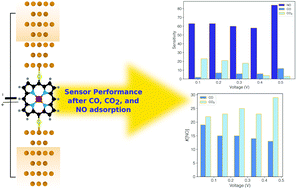Highly efficient metalloporphyrin-based nanosensors for NO detection†
Abstract
Research interest in chemical gas detection has been directed towards developing highly selective bio-inspired and eco-friendly materials that allow the integration of sensors in daily human life, such as the Internet of Things (IoT). In this regard, chemical sensors for detecting air pollutants are urgently needed for environmental safety. For instance, acute exposure to the colorless nitrogen oxide (NO)—as an anthropogenic gas—causes several diseases such as methemoglobinemia, emphysema, and bronchiolitis, to name just three. In the present work, to find materials for sensing the dilute amount of NO, we use the density functional non-equilibrium Green's function formalism to thoroughly screen the bio-inspired metalloporphyrin (MPor) based junctions. The detailed analysis of adsorption energy, sensitivity, recovery time, and selectivity reveals that the nature of the central M, mainly its orbitals’ energy ordering, affects the overall performance of MPors for sensor applications. We find that the the CrPor-based device is sensitive (≈0.85%) and also selective, in comparison with other pollutants like CO and CO2, toward NO detection. The contaminated sensor then can be recovered within 0.25 s at a small bias voltage of 0.5 V. The bio-inspired CrPor molecules are thus promising materials for designing superior NO nanoscale chemical sensors. Our computational approach provides a basis for the future optimization and development of gas nanosensors awaiting further experimental validations.



 Please wait while we load your content...
Please wait while we load your content...